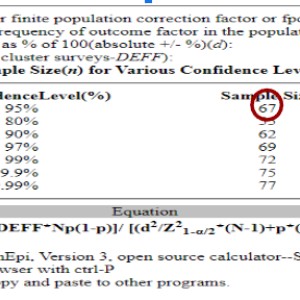Sample size calculation for a cross sectional healthcare study
I am currently working on a cross sectional study - An online survey will be distributed to healthcare workers to examine the current feeding practices on preterm babies. The sample size I obtained from an online software OpenEpi was 67 (CI 95%). Considering a 30% dropout rate, the final sample size needed for my study is 87. I am wondering if:
1. This number is sufficient for my study? Or if it's lacking?
2. Is the equation used in OpenEpi suitable for my study?
P.S. A very large sample size might be inappropriate d/t low response rate and limited available participants.
The attached picture is the print screen from OpenEpi. Appreciate any help. tqsm :)
Answer
Answers can only be viewed under the following conditions:
- The questioner was satisfied with and accepted the answer, or
- The answer was evaluated as being 100% correct by the judge.
 Kav10
Kav10
2.1K
The answer is accepted.
Join Matchmaticians Affiliate Marketing
Program to earn up to a 50% commission on every question that your affiliated users ask or answer.
- answered
- 1431 views
- $3.50
Related Questions
- Find a number for 𝛼 so f(x) is a valid probability density function
- Probabilities/ states question
- What statistical test should I use to compare 2 multiple linear regression models
- Proper Test Selection for Repeated Interval Data Collection?
- Combinations of factors not observed, non-full rank design matrix. How to explain to investigator?
- Hypothesis Testing, Probabilities
- Probability of drawing a red ball, given that the first ball drawn was blue?
- Equation Required/Formula


Very low bounty!
Hi! How much do you think it is worth?
Hi. I can give you general guidance on your questions. Some of them are not very clear. You can tip me after. Sounds good?
Yeah sounds good to me :)